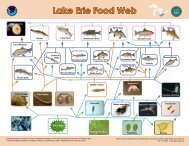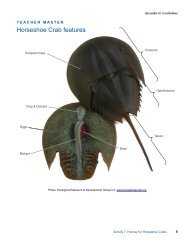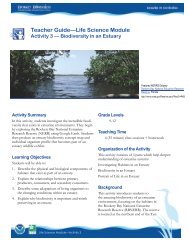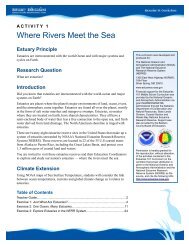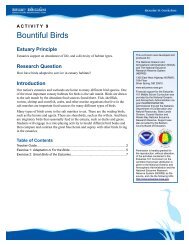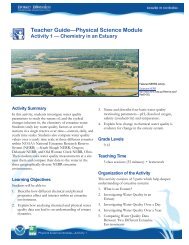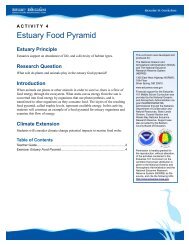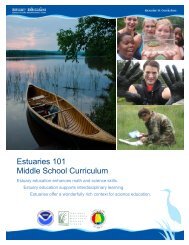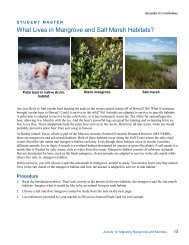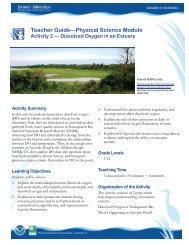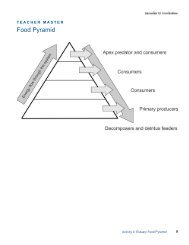Student Reading—1Activity 1: Observing <strong>Estuaries</strong>An estuary is a partially enclosed body of water, and itssurrounding coastal habitats, where saltwater from theocean mixes with fresh water from rivers, streams, orgroundwater. In fresh water, the concentration of salts,or salinity, is nearly zero. The salinity of water in theocean averages about 35 parts per thousand (ppt). Themixture of seawater and fresh water in estuaries is calledbrackish water.softer rocks are eroded away by relentlesswave action occurring over thousands ofyears. In contrast, sand bars, spits, and evenentire beaches can form, or be completelyobliterated, in a single severe storm. Estuaryfeatures such as salt marshes, bayous, andmangrove forests form in the areas protected bybarrier beaches, islands, and strips of coastal land.<strong>Estuaries</strong> are transitional areas that connect the landand the sea, as well as freshwater and saltwater habitats.The daily tides (the regular rise and fall of the sea’s surface)are a major influence on many of these dynamicenvironments. Most areas of the Earth experience twohigh and two low tides each day. Some areas, like theGulf of Mexico, have only one high and one low tideeach day. The tidal pattern in an estuary depends on itsgeographic location, the shape of the coastline andocean floor, the depth of the water, local winds, andany restrictions to water flow. For example, tides at theend of a long, narrow inlet might be heightened becausea large volume of water is being forced into avery small space. However, the change in sea level fortides in wetlands composed of broad mud flats mightappear to be rather small.While strongly affected by tides and tidal cycles, manyestuaries are protected from the full force of oceanwaves, winds, and storms by reefs, barrier islands, orfingers of land, mud, or sand that surround them. Thecharacteristics of each estuary depend upon the localclimate, freshwater input, tidal patterns, and currents.Truly, no two estuaries are the same.Besides the constant erosional forces of water andwind, coastal landforms and features are influenced byother large, long-term geologic events. Glaciersretreating during the last ice age sculpted the northeastcoastline of the United States. One look at thepeninsulas of Maine clearly shows the direction ofretreat of the mile-thick ice sheets. Only the hardestrock was left behind to form the islands and thepeninsulas of the coast. During this period, the entirebulk of Long Island was left behind by the forwardedge of a massive glacier, deposited like a load of dirtfrom a huge dump truck. Long Island Sound formed inthe gouge behind the rubble.In this activity, you will explore how landforms andfeatures change as you travel from the interior of ourcountry to the place where rivers empty into thesea—estuaries. Then, you will explore coastal regionsfrom above using Google Earth or other resources toidentify landforms and features associated withestuarine and coastal environments.Landforms that occur on or near the coast are shapedby wave and wind erosion and glacial transport. Headlandsare composed of the very hard rock left behind asEarth <strong>Science</strong> <strong>Module</strong>—Activity 1
Student Reading—2Activity 1: Introduction to Weeks Bay NERRThe Weeks Bay National Estuarine Research Reserve(NERR) includes over 6,000 acres of coastal wetlandsthat provide rich and diverse habitats for a variety offish, crustaceans and shellfish, as well as many uniqueand rare plants. Weeks Bay is a small estuary, about 8km 2 , receiving freshwater from the Magnolia and Fishrivers, and draining a 500 km 2 watershed into thelower portion of Mobile Bay. This sub-estuary ofMobile Bay averages just 1.5 meters in depth and isfringed with salt marshes dominated by black needlerush and cordgrass, as well as extensive swamps withpine, oak, magnolia, maple, cypress, bayberry, andtupelo trees.The Weeks Bay ecosystem contains many freshwaterand marine fish and invertebrate species. Collectively,these species support large commercial andrecreational fishing industries. Weeks Bay is especiallya critical nursery for shrimp, bay anchovy, blue craband multitudes of other fish, crustaceans andshellfish. The Reserve lands also include upland andbottomland hardwood forests, freshwater marsh,submerged aquatic vegetation, and unique boghabitats. Many of these areas are especially importantto the large number of trans-Gulf migratory birds as aresting and feeding area.Additionally, the Weeks Bay NERR is home to manythreatened or endangered species, including the WestIndian manatee, eastern fox squirrel, red-cockadedwoodpecker, wood stork, Alabama red-bellied turtle,gopher tortoise, and Alabama sturgeon.Although the Reserve is relatively undisturbed,increasing development pressure and populationgrowth within areas of the Weeks Bay watershed hasresulted in increasing sources of pollution. Theseinclude storm water runoff from parking lots,industrial sites, leaking septic tanks, and landfills, aswell as, agricultural runoff. Input of excessivenutrients and sediments from this runoffcan have detrimental affects on estuarylife including reduction in submergedaquatic vegetation, increase in algalblooms which cause fish kills, andaccumulation of toxic substances withinshellfish.Figure 1. Weeks Bay NERR is home to many species ofplants and animals.Earth <strong>Science</strong> <strong>Module</strong>—Activity 12



